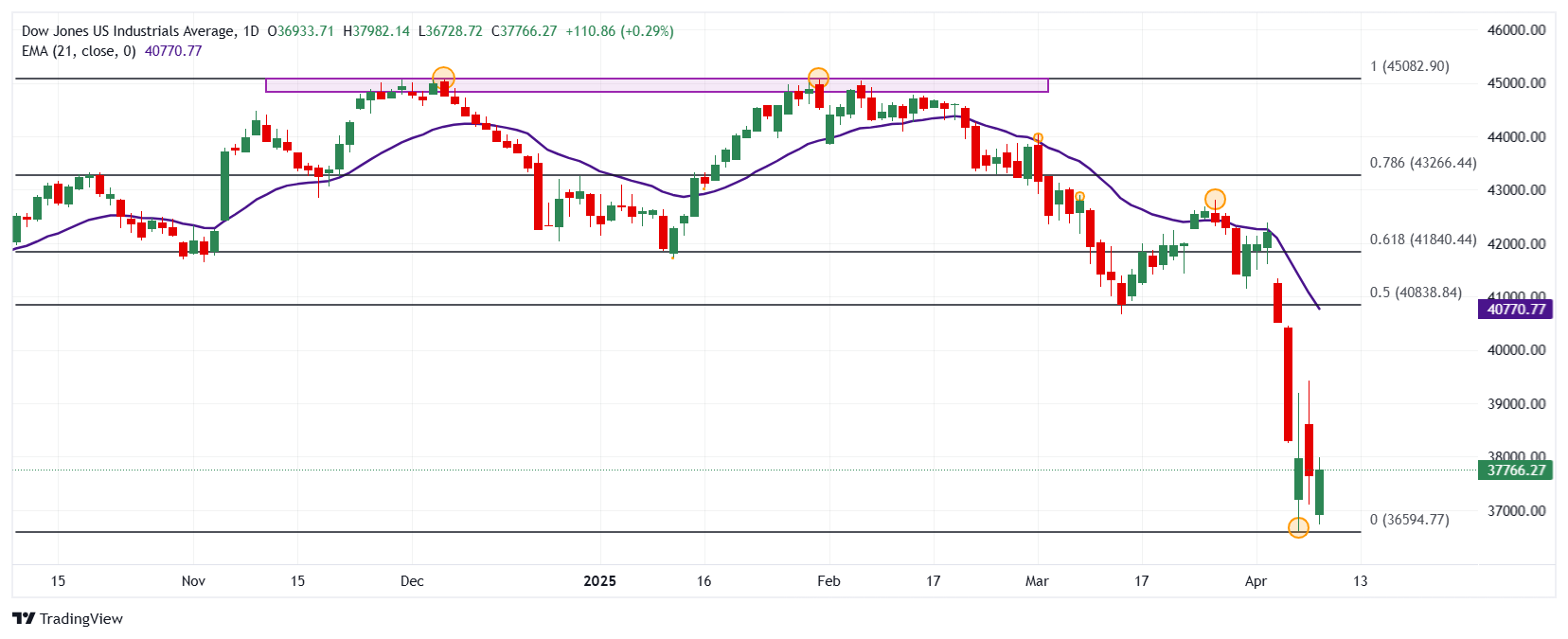- The Dow Jones rises 0.08% daily, quoting when writing about 37,686.
- The Nasdaq 100 rebounds 1.05% today, led by Strategy Incorporated (Mstr).
- The S&P 500 wins 0.25% in the day, staying within the range of the previous session.
- China announces additional tariffs of 84% to goods from the United States, effective as of April 10.
- The attention of investors will be set on the minutes of the Federal Reserve, to be published at the close of the market.
The Dow Jones established a maximum of the day in 37,854, where he found aggressive vendors that took the index to a minimum of two days in 36,728.
The Dow Jones industrial average began negotiations in 36,933, while the Nasdaq 100 technological index opened at 17,098. The S&P 500 began operating in 4,933, waiting for the publication of FOMC minutes.
Nvidia Corporation and Walmart keep Dow Jones on positive terrain
The Dow Jones index wins 0.08% on Wednesday, going up 146 points, currently quoting at 37,686.
The actions of Nvidia (NVDA) rebound 3.97% today, operating currently over 100.11, consolidating in the operational range of Tuesday.
Following the upward perspective, Wlart (WMT) values lead the profits in the Dow Jones, climbing 5.27% daily, reaching a maximum of the day at 86.24 $.
In this context, Dow Jones goes up 236 points in the day, finding buying interest from a minimum of April 7 at 37,982.
The Nasdaq 100 is quoted on the ride by Strategy Incorporated and Advanced Micro Devices
The Nasdaq 100 technological index rebounds 0.95% today, reaching a daily maximum in 17,444.
Strategy Incorporated (MSTR) shares shoot 4.89% daily, quoting at the time of writing about 249.78 $, operating within the range of Tuesday’s session.
On the other hand, Advanced Micro Devices (AMD) values rise 4.37% in the day, currently operating in $ 81,91, partially recovering from the loss of 6.49% suffered yesterday.
The Nasdaq 100 takes up the winning path, operating at the moment over 17,294, in the midst of a commercial war that worries the supplies chains of technological companies, as well as a possible increase in the cost of their components.
The S&P 500 operates with profits in the middle of an intense commercial war
According to information provided by China’s Ministry of Finance, the Asian country has decided to impose tariffs of 84% to all assets from the United States, as retaliation at 104% rates imposed by administration led by Donald Trump.
After this news, the S&P 500 struggles to stay in a profit zone, rising 0.25% today, consolidating within the previous session range in 4,996.
On the other hand, investors will focus their attention on the publication of the Minutes of the Federal Reserve, at the end of the American session. Operators expect it to provide clarity in relation to the rhythm of interest rates taking into account the inflationary risks caused by tariffs.
Technical Analysis of Dow Jones
The Dow Jones established a short -term resistance given by the maximum of March 26 in 42,820, in convergence with the exponential mobile average of 21 periods. The next key resistance is observed at 45,068, maximum of January 31. To the south, the key support is at 35,953, a pivot point of December 8, 2023.
Dow Jones daily graphics

Dow Jones Faqs
The Dow Jones Industrial Avenge, one of the oldest stock market indexes in the world, consists of the 30 most negotiated values in the United States. The index is weighted by the price instead of capitalization. It is calculated by adding the prices of the values that compose it and dividing them by a factor, currently 0.152. The index was founded by Charles Dow, also founder of the Wall Street Journal. In recent years it has been criticized for not being sufficiently representative, since it only follows 30 companies, unlike broader rates such as S&P 500.
There are many factors that promote the Dow Jones Industrial Average (DJIA) index. The main one is the added performance of the companies that compose it, revealed in the quarterly reports of business benefits. The American and world macroeconomic data also contribute, since they influence investor confidence. The level of interest rates, set by the Federal Reserve (FED), also influences the DJia, since it affects the cost of credit, on which many companies depend largely. Therefore, inflation can be a determining factor, as well as other parameters that influence the decisions of the Federal Reserve.
Dow’s theory is a method to identify the main trend of the stock market developed by Charles Dow. A key step is to compare the direction of the Dow Jones Industrial Avenge (DJIA) and the Dow Jones Transportation Average (DJTA) and just follow the trends in which both move in the same direction. The volume is a confirmation criterion. The theory uses elements of maximum and minimum analysis. Dow’s theory raises three phases of the trend: accumulation, when intelligent money begins to buy or sell; Public participation, when the general public joins the trend; and distribution, when intelligent money abandons the trend.
There are several ways to operate with the DJ. One of them is to use ETF that allow investors to negotiate the DJ as a single value, instead of having to buy shares of the 30 companies that compose it. An outstanding example is the SPDR Dow Jones Industrial Avenge ETF (day). Future contracts on the DJ allow the specular operators about the future value of the index and the options provide the right, but not the obligation, to buy or sell the index at a predetermined price in the future. Investment funds allow investors to buy a part of a diversified portfolio of DJ values, which provides exposure to global index.
Source: Fx Street
I am Joshua Winder, a senior-level journalist and editor at World Stock Market. I specialize in covering news related to the stock market and economic trends. With more than 8 years of experience in this field, I have become an expert in financial reporting.







